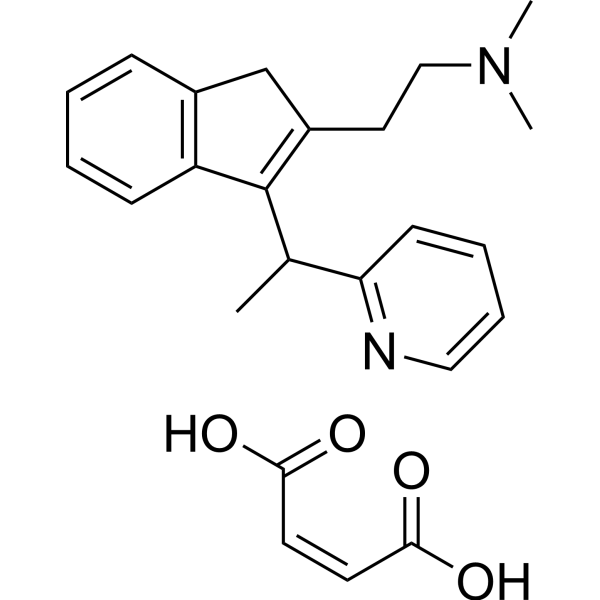
Dimethindene maleate
CAS No. 3614-69-5
Dimethindene maleate ( SU 6518; SU-6518; UNII-6LL60J9E0O; Dimethindene maleate )
Catalog No. M27412 CAS No. 3614-69-5
Dimethindene maleate is a histamine H1 antagonist and can be used in studies about the treatment of hypersensitivity reactions, pruritus and rhinitis.
Purity : >98% (HPLC)
 COA
COA
 Datasheet
Datasheet
 HNMR
HNMR
 HPLC
HPLC
 MSDS
MSDS
 Handing Instructions
Handing Instructions
| Size | Price / USD | Stock | Quantity |
| 5MG | 87 | In Stock |


|
| 10MG | 140 | In Stock |


|
| 25MG | 295 | In Stock |


|
| 50MG | 475 | In Stock |


|
| 100MG | 692 | In Stock |


|
| 500MG | 1422 | In Stock |


|
| 1G | Get Quote | In Stock |


|
Biological Information
-
Product NameDimethindene maleate
-
NoteResearch use only, not for human use.
-
Brief DescriptionDimethindene maleate is a histamine H1 antagonist and can be used in studies about the treatment of hypersensitivity reactions, pruritus and rhinitis.
-
DescriptionDimethindene maleate is a histamine H1 antagonist and can be used in studies about the treatment of hypersensitivity reactions, pruritus and rhinitis.
-
SynonymsSU 6518; SU-6518; UNII-6LL60J9E0O; Dimethindene maleate
-
PathwayGPCR/G Protein
-
TargetHistamine Receptor
-
Recptor——
-
Research Area——
-
Indication——
Chemical Information
-
CAS Number3614-69-5
-
Formula Weight408.5
-
Molecular FormulaC24H28N2O4
-
Purity>98% (HPLC)
-
Solubility——
-
SMILESC1(=C(Cc2c1cccc2)CCN(C)C)[C@@H](c1ncccc1)C.C(\C=C/C(=O)O)(=O)O
-
Chemical Name——
Shipping & Storage Information
-
Storage(-20℃)
-
ShippingWith Ice Pack
-
Stability≥ 2 years
Reference
1.K D Brunnemann, et al. N-Nitrosomorpholine and Other Volatile N-nitrosamines in Snuff Tobacco. Carcinogenesis. 1982;3(6):693-6.
molnova catalog


related products
-
Sodium butanoate
Sodium Butyrate(Butanoic acid sodium salt) has been reported to cause hyperacetylation of histones due to its role as a histone deacetylase (HDAC) inhibitor (IC50 values are 0.3, 0.4, 0.3, mM for HDAC1, 2 and 7 respectively).
-
Ciproxifan maleate
Ciproxifan maleate(FUB-359 maleate) is a highly potent and selective histamin H3-receptor antagonist with IC50 of 9.2 nM, with low apparent affinity at other receptor subtypes.
-
Esculetin
Esculetin is slightly soluble (in water) and a very weakly acidic compound (based on its pKa). Esculetin can be found in a number of food items such as dandelion, highbush blueberry, wild leek, and opium poppy.



 Cart
Cart
 sales@molnova.com
sales@molnova.com


